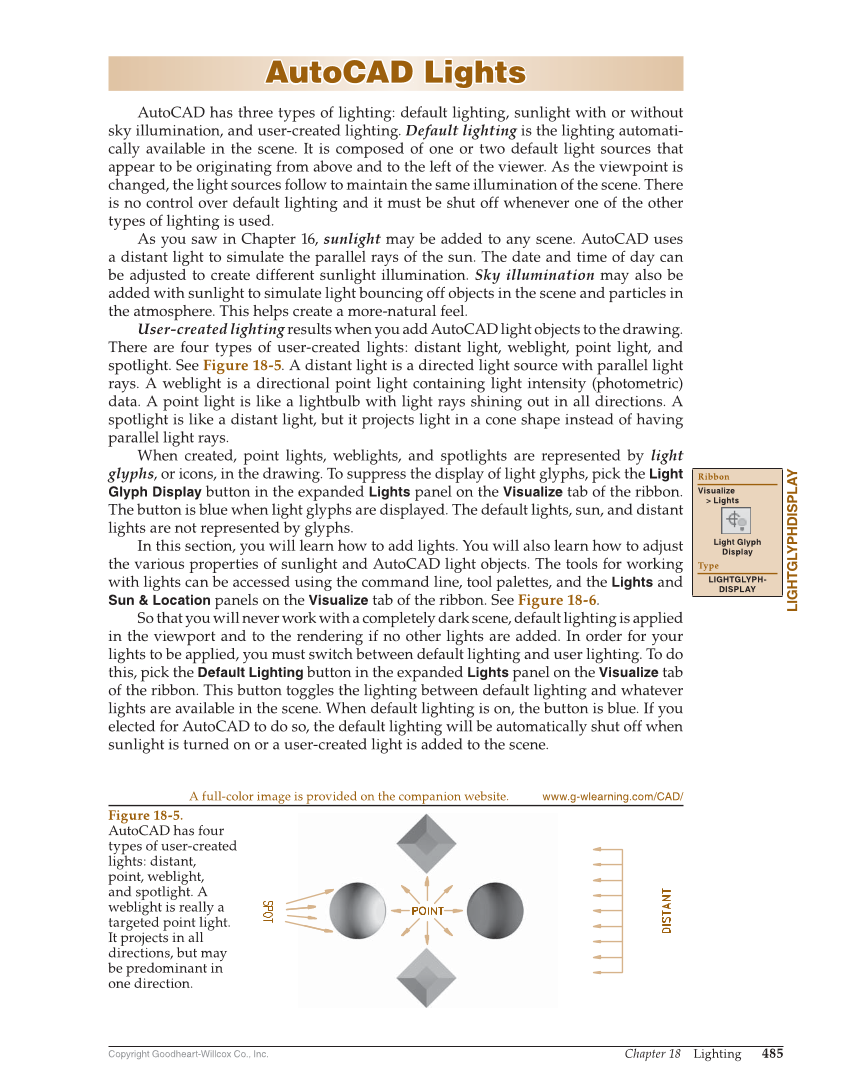Copyright Goodheart-Willcox Co., Inc. Chapter 18 Lighting 485 AutoCAD Lights AutoCAD Lights AutoCAD has three types of lighting: default lighting, sunlight with or without sky illumination, and user-created lighting. Default lighting is the lighting automati- cally available in the scene. It is composed of one or two default light sources that appear to be originating from above and to the left of the viewer. As the viewpoint is changed, the light sources follow to maintain the same illumination of the scene. There is no control over default lighting and it must be shut off whenever one of the other types of lighting is used. As you saw in Chapter 16, sunlight may be added to any scene. AutoCAD uses a distant light to simulate the parallel rays of the sun. The date and time of day can be adjusted to create different sunlight illumination. Sky illumination may also be added with sunlight to simulate light bouncing off objects in the scene and particles in the atmosphere. This helps create a more-natural feel. User-created lighting results when you add AutoCAD light objects to the drawing. There are four types of user-created lights: distant light, weblight, point light, and spotlight. See Figure 18-5. A distant light is a directed light source with parallel light rays. A weblight is a directional point light containing light intensity (photometric) data. A point light is like a lightbulb with light rays shining out in all directions. A spotlight is like a distant light, but it projects light in a cone shape instead of having parallel light rays. When created, point lights, weblights, and spotlights are represented by light glyphs, or icons, in the drawing. To suppress the display of light glyphs, pick the Light Glyph Display button in the expanded Lights panel on the Visualize tab of the ribbon. The button is blue when light glyphs are displayed. The default lights, sun, and distant lights are not represented by glyphs. In this section, you will learn how to add lights. You will also learn how to adjust the various properties of sunlight and AutoCAD light objects. The tools for working with lights can be accessed using the command line, tool palettes, and the Lights and Sun & Location panels on the Visualize tab of the ribbon. See Figure 18-6. So that you will never work with a completely dark scene, default lighting is applied in the viewport and to the rendering if no other lights are added. In order for your lights to be applied, you must switch between default lighting and user lighting. To do this, pick the Default Lighting button in the expanded Lights panel on the Visualize tab of the ribbon. This button toggles the lighting between default lighting and whatever lights are available in the scene. When default lighting is on, the button is blue. If you elected for AutoCAD to do so, the default lighting will be automatically shut off when sunlight is turned on or a user-created light is added to the scene. LIGHTGLYPHDISPLAY Ribbon Visualize Lights Light Glyph Display Type LIGHTGLYPH- DISPLAY Figure 18-5. AutoCAD has four types of user-created lights: distant, point, weblight, and spotlight. A weblight is really a targeted point light. It projects in all directions, but may be predominant in one direction. A full-color image is provided on the companion website. www.g-wlearning.com/CAD/
